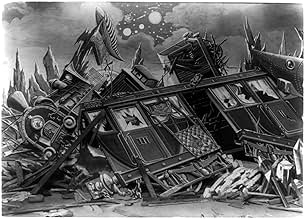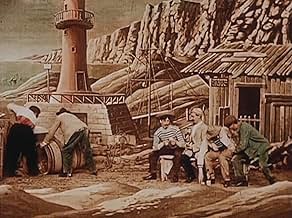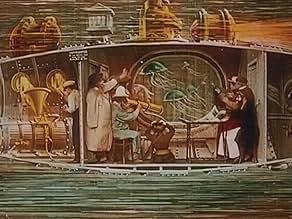NOTE IMDb
7,4/10
4,3 k
MA NOTE
Ajouter une intrigue dans votre langueUsing every known means of transportation, several savants from the Geographic Society undertake a journey through the Alps to the Sun which finishes under the sea.Using every known means of transportation, several savants from the Geographic Society undertake a journey through the Alps to the Sun which finishes under the sea.Using every known means of transportation, several savants from the Geographic Society undertake a journey through the Alps to the Sun which finishes under the sea.
- Réalisation
- Scénario
- Casting principal
Fernande Albany
- Madame Latrouille
- (non crédité)
Jehanne d'Alcy
- Villager at seaport
- (non crédité)
May de Lavergne
- Nurse in Swiss hospital
- (non crédité)
Avis à la une
I suppose you could consider this film as a spiritual follow up to A Trip to the Moon. The latter remains George Méliès most famous and iconic film; probably for good reason considering its ambition and imagination. An Impossible Voyage explores similar territory and is certainly a worthy companion-piece as an example of early cinematic science fiction.
In this one a group of scientists don't go to the moon, they head further afield to the sun. Perhaps this illustrates Méliès reaching out further too. Certainly this is another example of him developing the idea of what cinema could be. Unlike most of his peers, he was taking the medium into the story-telling sphere. Films like this were in this sense the beginnings of modern cinema as we know it.
The film features a nice colour tint that adds a great deal to the fantastical look. It contains a number of hand painted sets that gives it all a highly stylised look. The scientists' adventure not only takes them to the sun but also across the mountains of Switzerland, which Méliès also depicts like an alien landscape. The travellers end up in the bottom of the ocean completing their amazing journey. All in all this is an entertaining and highly imaginative work, well worth catching.
In this one a group of scientists don't go to the moon, they head further afield to the sun. Perhaps this illustrates Méliès reaching out further too. Certainly this is another example of him developing the idea of what cinema could be. Unlike most of his peers, he was taking the medium into the story-telling sphere. Films like this were in this sense the beginnings of modern cinema as we know it.
The film features a nice colour tint that adds a great deal to the fantastical look. It contains a number of hand painted sets that gives it all a highly stylised look. The scientists' adventure not only takes them to the sun but also across the mountains of Switzerland, which Méliès also depicts like an alien landscape. The travellers end up in the bottom of the ocean completing their amazing journey. All in all this is an entertaining and highly imaginative work, well worth catching.
Having produced a blockbuster in 1903 in which a group of scientists journeyed to the moon, Melies tried to outdo himself the following year by having another group of manic scientists travel to the sun. He made this film longer and stencilled it in colour, and the outcome is quite astounding. To think that Melies was producing lengthy masterpieces like this while contemporary filmmakers were still experimenting with one-shot narratives goes to show how far ahead of his time Melies really was - which makes his downfall less than a decade later all the sadder. Melies fills the screen with colour with sets sometimes similar to the expressionist sets of the German masterpieces of the late teens and 20s, and fills it also with movement. Not one moment passes when there isn't something to look at. Although this film is not as widely known as Le Voyage dans la lune for my money it surpasses it in terms of exuberance and imagination.
really a great hand colored early science fiction movie with full of early special effects,greatest moment in the film that they reach the sun and go into the suns mouth with a train,this scene is very familiar with the trip to the moon when they reach the moon. The tour through the swiss landscape is also a great moment.
What an interesting and unusual little feature this is - the combination of Méliès and Jules Verne always produces something worth seeing, and this one is based on one of Verne's most fantastical ideas. It follows a group of scientists and scholars on a very fanciful trip that uses every imaginable form of conveyance, and the story gives Méliès all kinds of opportunities for his trademark visual effects.
Each scene is packed with details, so much so that you cannot even catch it all in one viewing. It is also color-tinted in many places, which adds even more to the effect. The story is just wild, and is less plausible than many Verne stories, but that does not detract from it as entertainment. Méliès even tosses in a little slapstick, which is not too bad for its time. It is similar to, and just a cut below, his film of Verne's "Trip to the Moon", and anyone who enjoyed that classic should also like this one.
Each scene is packed with details, so much so that you cannot even catch it all in one viewing. It is also color-tinted in many places, which adds even more to the effect. The story is just wild, and is less plausible than many Verne stories, but that does not detract from it as entertainment. Méliès even tosses in a little slapstick, which is not too bad for its time. It is similar to, and just a cut below, his film of Verne's "Trip to the Moon", and anyone who enjoyed that classic should also like this one.
This is a crazy, delightful mess. Explorers make an effort to go to lands never seen and report back. They try to use every conceivable vehicle to go over mountains, under seas, through outer space, actually visiting the sun (I wonder if they went at night so they wouldn't get burned). There are laughs galore because the stuffed shirt explorers were in no way equipped to do any kind of huge investigation. No matter what horrible things happen to them, getting frozen, blown up, crashing from a hundred miles away, going through the sun, and on and on, they always make their way out. One of the stars of this film is the painted scenery. Melies really liked the jagged edges of the mountains and wacky surreal realms of the outer world.
Le saviez-vous
- AnecdotesIncluded in the "Georges Melies: First Wizard of Cinema (1896-1913)" DVD collection, released by Flicker Alley.
- GaffesFor a few seconds, a pole can clearly be seen holding the anthropomorphic sun up.
- Versions alternativesAlso available in a computer colorized version.
- ConnexionsFeatured in Karl May, à la recherche du paradis perdu (1974)
Meilleurs choix
Connectez-vous pour évaluer et suivre la liste de favoris afin de recevoir des recommandations personnalisées
Détails
- Date de sortie
- Pays d’origine
- Langues
- Aussi connu sous le nom de
- Voyage à travers l'impossible
- Lieux de tournage
- Sociétés de production
- Voir plus de crédits d'entreprise sur IMDbPro
Box-office
- Budget
- 37 500 F (estimé)
- Durée24 minutes
- Couleur
- Mixage
- Rapport de forme
- 1.33 : 1
Contribuer à cette page
Suggérer une modification ou ajouter du contenu manquant









